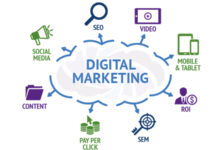
Everything You Need to Know About Website Marketing
Online marketing is more important in the post-COVID world. Consumers are used to buying everything from groceries to pet supplies online.
They like the convenience and they’re willing to spend time online to find the best vendor. If you don’t have an ecommerce business, people want to make sure you have a legitimate business.
Almost half of all consumers think web design is the main factor to determine if a business is credible or not. Your site’s design forms 75% of a person’s impression of your business.
Web marketing has to be at the top of your business agenda if you want to succeed.
Consumers have more power and control than ever. You have to meet them where they’re at. If you’re in need of web marketing tips, read on to learn how you can create a web marketing strategy.
1. Create Web Marketing Goals
Do you know why you have a website? What do you want web marketing to do for your business?
These are questions that help you determine some of the strategies you’ll implement. A web marketing strategy that focuses on your business goals makes everything else easy.
For instance, if the purpose of your website is to have visitors book appointments, your web marketing strategy will come into play in the later stages of the buying cycle.
If you want people to sign up to your list, think about strategies that capture attention in the earlier stages of the buying cycle.
You’ll then develop a clear set of goals that you can measure. You can set metrics for sales, conversions, or traffic. Marketers that set multiple goals should set priorities so your goals don’t end up competing with each other.
2. Clean Up Your Website
There are two parts to successful web marketing. The first is to drive traffic to your site. The second is to make your site so good, visitors want to take the next step.
You need to make sure your site’s design exceeds customer expectations. Remember, your site’s design is tied to your credibility.
If you give them a poor design, they won’t bother with anything else. Give them a good user experience and they’ll sign up for your newsletter, book an appointment, or buy something.
Make sure you clean up your website before you drive a ton of traffic to it. Check the site speed, make sure it’s secure, and create a modern design that reflects your brand.
Not every person is an expert in design, nor are they technical experts. Website design services are worth it to ensure the best possible result.
3. Do Target Market Research
Don’t overlook learning about your target market. Too many business owners have a general sense of their market, but web marketing requires a deep understanding.
You have to present your business in a way that solves their deepest problems. Think beyond what your product or service does.
You have to know how it makes them feel. You also have to understand how they feel if they don’t do anything about their problem.
A gym owner knows that people don’t show up every day to lose weight. They want to feel more attractive and confident.
You then need to find out how people solve their problems online. They’ll use search engines, scroll through social media, or watch videos.
Make a list of the search terms and websites they use to find solutions.
4. Write Useful Blog Content
Take your list of search terms and write blog posts that answer those inquiries. For instance, if you find that your audience searches for “how to lose weight fast,” you can create a long blog post to show them how.
That helps build trust and you’ll become known as a trusted voice in your industry.
Do this on a regular basis, and you’ll get plenty of traffic from search engines.
5. Use Paid Ads
Some people have website marketing backward. They invest a ton of money on paid ads first, then they test and refine their messages, and then they work on the organic aspects of digital marketing.
That’s a very expensive way to conduct market research and test your methods.
Test and refine your messages using organic methods, such as SEO and social media. Once you gain traction in those areas, paid ads will accelerate your results.
You’re already confident that you know your target audience and what they’ll respond to. A paid ad campaign will work right away, so you get a higher ROI.
6. Don’t Overlook Remarketing
Remarketing is a paid ad campaign that recaptures lost website traffic. When people first visit your website, a very small percentage are ready to book an appointment or make a purchase.
The chances of someone revisiting your site based on one interaction is low. They’ll forget or they won’t see your brand elsewhere.
Remarketing keeps your brand in front of people after they leave your site. Remarketing places a cookie on a visitor’s browser (with their permission).
That cookie is part of a display ad campaign. When people visit other ad-based sites within the ad network, they’ll see your display ad.
That reminds them of your brand and they can click the ad to return to your site.
The Top Web Marketing Tips and Insights
Your website is the hub of your online marketing efforts. You want to make the best impression possible so people will think you have a credible business.
The web marketing tips in this article show you how to create a strategy that gets results. Always set goals and learn about your target audience.
Create content that they find useful and use remarketing to encourage them to revisit your site. Over time, they’ll grow to trust your brand.
If you enjoyed learning about digital marketing, you’ll enjoy the other tech articles on this site. Check them out today!








